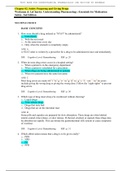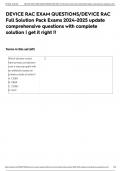Tentamen (uitwerkingen)
Test Bank For Anatomy and Physiology for The Human Body in Health & Disease 8th Edition Authors Kevin T. Patton & Frank B. Bell & Ter
- Vak
- Nursing
- Instelling
- Alabama State University
Test Bank for Anatomy and Physiology for the Human Body in Health & Disease, 8th Edition Master the complexities of human anatomy and physiology with the Test Bank for Anatomy and Physiology for the Human Body in Health & Disease, 8th Edition, authored by Kevin T. Patton, Frank B. Bell, and Ter....
[Meer zien]












